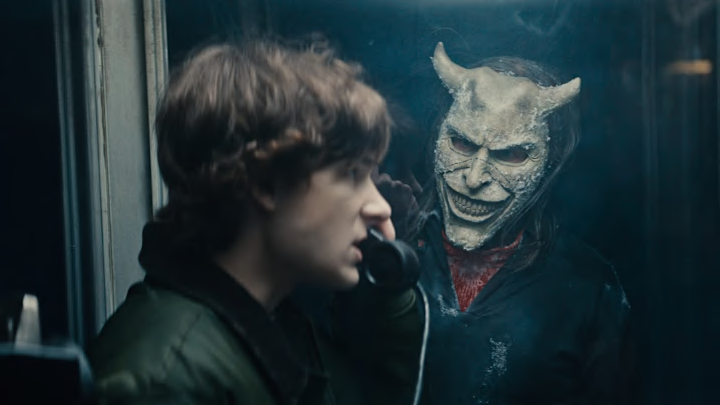I doubt many asked for a sequel to Scott Derrickson’s 2022 horror hit The Black Phone, especially considering how its primary antagonist, The Grabber (Ethan Hawke), gets killed at the hands of Finney (Mason Thames) during its climax. However, and most surprisingly so, Derrickson’s second entry in his horror pictures, which he and screenwriter C. Robert Cargill adapted from Joe Hill’s short story of the same name, is superior in every conceivable way, formally and thematically, to the admittedly decent but forgettable first chapter.
What’s most striking in Black Phone 2 is how Derrickson and cinematographer Pär M. Ekberg represent the subconscious of Finney’s sister, Gwen (Madeline McGraw), through blown-up Super 8mm and Super 16mm footage. It gives each dream sequence (or, in this case, nightmares) an uneasy feel that doesn’t need to be exacerbated through cheap jump scares or loud, overbearing noises. The photography itself is scary enough, because the perception in which Gwen is – a limbo state between total slumber and consciousness – brings about immediate danger to everyone around her.
Many who enter Black Phone 2 may think that Derrickson would be a fool to bring The Grabber back from the dead, or at least make sense in how he would be able to kill again. To those people, I’ve got good news for you: the Grabber is still dead. However, he becomes a manifestation of the trauma Finney and Gwen are enduring ever since he was killed, and haunts Gwen’s dreams, who is still riddled by the tragic passing of her mother (played by Anna Lore).
Worse yet, Finney is still grappling with the events that transpired in the original film, consistently hearing telephone noises and numbing himself from the physical and psychological pain of trauma through excessive cannabis consumption. Derrickson could’ve absolutely explored this aspect of the character a bit more, but it’s still interesting that, even many years after the events of the first film have transpired, Finney still hasn’t recovered from them.
A new main character for Black Phone 2
With all that being said, Finney is not the main character of the movie. Derrickson and Cargill instead shift gears to Gwen, who is having trouble separating her dreams from the reality she lives in, and is in a constant state of danger whenever she closes her eyes, since the Grabber is patiently waiting for her to fall into a deep slumber before he enacts his plan of revenge.
In this case, the Grabber acts more like Freddy Krueger, harmless in the real world, but can inflict massive physical damage within the characters’ dreams. Whenever the Grabber kills someone in their sleep, they die in real life, and, if they survive, the dreams create lasting psychological distress upon them. That might be the most glorified knockoff of Wes Craven’s A Nightmare on Elm Street I’ve ever seen—and unabashedly so, too. However, when Derrickson’s aesthetic impulses are so formally sound, and the mise-en-scène is genuinely spine-tingling, one can’t complain too much about what’s in front of us.
The thing is, Derrickson and Cargill never outright copy Craven’s film. Of course, there are obvious points of reference throughout, especially during a bravura scene where editor Louise Ford cuts between Gwen’s dream, where she’s violently attacked by the Grabber, and the real world, where Finney and employees of Camp Alpine Lake, where the two were investigating the origins of the film’s antagonist, see that the Grabber’s presence is real.
Derrickson goes hard in blurring the line between dreams (a construct of our imagination) and reality (filled with things that can hurt us), and ensures that audiences who are slightly frightened will not be able to turn the lights off as they go to sleep after viewing Black Phone 2. The violence is intense and often shocking, yet the Doctor Strange filmmaker still manages to visualize physically comedic kills, especially in the latter half, where ‘80s cheese impulses—think Curtains or Sleepaway Camp—are on full display.

A funnier and more entertaining sequel
Black Phone 2, being as funny as it is, was also not on my bingo card. Yet, making it less physiologically punishing for the protagonists and more entertaining for the audience is also why the sequel works as well as it does. We’re no longer confined to one space—Finney and Gwen go to a secluded Christian camp to inquire about the real nature of their mother’s death, which allows Derrickson to stage large-scale sequences on a frozen lake (where most of the fun takes place), inside the bunk room of the camp, and, of course, the kitchen.
While the Grabber’s presence is more sparse than in the first, Hawke gives a more petrifying turn here, simply in how his voice acts as the catalyst for the trauma both characters are enduring. Thames is admirable, but it’s Madeline McGraw who consistently steals the show. Gwen is, after all, the protagonist of this picture, and always has the last laugh. She’s the character whom you always latch onto, no matter how distressing the events of the movie get.
Derrickson does wrap up his movie a bit too quickly, and perhaps Black Phone 2 doesn’t make as much narrative sense as the original (the machinations of how the Grabber can operate in the dream world are never really explained and are instead defined on the fly). But also, who cares?
When the movie is this cool and stages one effective sequence after the next, where the filmmaker has fun playing in a sandbox that has become less interested in scaring the audience, “plotholes” should be the least of your problems. At the end of the day, Derrickson shows us that there are still some artists who dare to ensure that at least we’ll think twice before closing our eyes in the evening and entering a world that we can’t necessarily control. For horror movies, that’s all that matters.
Get the latest movie reviews and updates from FlickSided.
